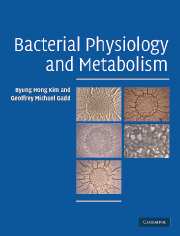Book contents
- Frontmatter
- Contents
- Preface
- 1 Introduction to bacterial physiology and metabolism
- 2 Composition and structure of prokaryotic cells
- 3 Membrane transport – nutrient uptake and protein excretion
- 4 Glycolysis
- 5 Tricarboxylic acid (TCA) cycle, electron transport and oxidative phosphorylation
- 6 Biosynthesis and microbial growth
- 7 Heterotrophic metabolism on substrates other than glucose
- 8 Anaerobic fermentation
- 9 Anaerobic respiration
- 10 Chemolithotrophy
- 11 Photosynthesis
- 12 Metabolic regulation
- 13 Energy, environment and microbial survival
- Index
- References
2 - Composition and structure of prokaryotic cells
Published online by Cambridge University Press: 05 September 2012
- Frontmatter
- Contents
- Preface
- 1 Introduction to bacterial physiology and metabolism
- 2 Composition and structure of prokaryotic cells
- 3 Membrane transport – nutrient uptake and protein excretion
- 4 Glycolysis
- 5 Tricarboxylic acid (TCA) cycle, electron transport and oxidative phosphorylation
- 6 Biosynthesis and microbial growth
- 7 Heterotrophic metabolism on substrates other than glucose
- 8 Anaerobic fermentation
- 9 Anaerobic respiration
- 10 Chemolithotrophy
- 11 Photosynthesis
- 12 Metabolic regulation
- 13 Energy, environment and microbial survival
- Index
- References
Summary
Like all organisms, microorganisms grow, metabolize and replicate utilizing materials available from the environment. Such materials include those chemical elements required for structural aspects of cellular composition and metabolic activities such as enzyme regulation and redox processes. To understand bacterial metabolism, it is therefore helpful to know the chemical composition of the cell and component structures. This chapter describes the elemental composition and structure of prokaryotic cells, and the kinds of nutrients needed for biosynthesis and energy-yielding metabolism.
Elemental composition
From over 100 natural elements, microbial cells generally only contain 12 in significant quantities. These are known as major elements, and are listed in Table 2.1 together with some of their major functions and predominant chemical forms used by microorganisms.
They include elements such as carbon (C), oxygen (O) and hydrogen (H) constituting organic compounds like carbohydrates. Nitrogen (N) is found in microbial cells in proteins, nucleic acids and coenzymes. Sulfur (S) is needed for S-containing amino acids such as methionine and cysteine and for various coenzymes. Phosphorus (P) is present in nucleic acids, phospholipids, teichoic acid and nucleotides including NAD(P) and ATP. Potassium is the major inorganic cation (K+), while chloride (Cl−) is the major inorganic anion. K+ is required as a cofactor for certain enzymes, e.g. pyruvate kinase. Chloride is involved in the energy conservation process operated by halophilic archaea (Section 11.6). Sodium (Na+) participates in several transport and energy transduction processes, and plays a crucial role in microbial growth under alkaline conditions (Section 5.7.4).
- Type
- Chapter
- Information
- Bacterial Physiology and Metabolism , pp. 7 - 34Publisher: Cambridge University PressPrint publication year: 2008



